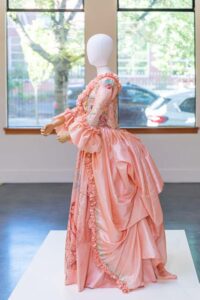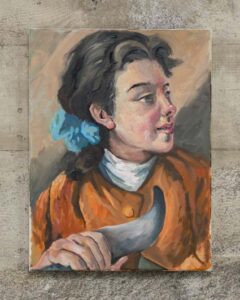Alexander Stanfield

Assisted by Seraphim Hong and Anh Nguyen
Conté and marker on sateen $8,000
After Boucher, a nuanced solo exhibition of subversion and representation by Molly Jae Vaughan, is showing until Oct 24th at the Fuller Rosen Gallery in Portland, Oregon, United States. All the pieces in this collection are directly influenced by Boucher works from one book of 60 pieces titled The Drawings of François Boucher by Alastair Laing. This culmination of five years of Vaughan’s dedication presents the works of François Boucher in a new light. Utilizing classic Rococo content, Vaughan repurposes the Boucher works to create a discussion about Queer bodies, identity, and exploitation.
Vaughan, a senior associate professor of art at Bellevue University in Washington, began making work as an openly trans woman as of 2011 and celebrates the representation of trans bodies in their work. There are several mediums at play in this show ranging from crayon, acrylic, sateen, and more. This attests to how an artist’s work can shift over time, but also directly references the many mediums and crafts Boucher utilized in his own work.
As an artist of the Rococo, Boucher’s work has an inviting sense of movement to it. Ornamental structures, sweeping fabric, theatrical poses and silhouettes fill the subject matter as excessive amounts of material and movement spill out of the image. Vaughan has replicated this treatment of the subject matter and taken the soft color palettes to another place with vibrant pastels while keeping the Classical iconography and powdered wigs for that period touch. Their treatment of color and lines takes these images almost into the realm of graphic design, echoing work of other French artists from the late 19th-century.
Gender and sexuality are at the forefront of this collection, but not in the way you might think. Vaughan has added a notable aspect to these identifiably Rococo settings: the Minotaur. The choice to include this classical character is fun, and clever, but it also adds another layer to Vaughan’s conversation with the audience. Minotaurs were vilified and ostracized for being outside conventional constructs. Vaughan has used imagery like this in their work before because they identify with this placement as a member of the queer community.
Anthropomorphized bodies are present where the conventionally gendered bodies once occupied Boucher’s images. Aside from an artist further connecting with their audience through their work, this choice of imagery subverts traditional Rococo subject matter by removing a commonly, but unfortunately, used perspective of the heteronormative male gaze.
Rococo compositions were usually dominated by scenes of leisure, parties, and diversions of the affluent. This was often connected to an exploitive point of view. Throughout the Rococo period the Gaze often found its eyes resting on the young country girl of low economic status, being exploited by the upper, predominantly male class. Being preyed upon is undoubtedly a concern, a fear that Vaughan has either dealt with themselves or experienced through others in their communities. These tense situations are a concept that speaks to the plight of many queer individuals today. The creativity of Vaughan in removing the effectiveness of the Gaze repurposes these Rococo scenes, allowing them to enter a new dialogue with the viewer.
A well-executed example of this is Young Country Girl Dancing. As the first image in the catalog, it sets the tone for the remainder of the exhibition. Vaughan has kept the original subject of a dancer but replaced the human likeness with that of a swan head. By removing the conventionally young female visage Vaughan has taken away the exploitative perspective. This in turn makes the viewer’s role pivot to focus on other aspects of the image, not just the gender identity.

oil on linen. $3,000
Photos courtesy Mario Gallucci © 2021
Many of the works in this show are eye-catching. The most striking is a dress located in the center of the room. Unlike the other works in the exhibition, this is a three-dimensional piece that forces the viewer to walk around it in order to fully take in the article’s decoration. Hand-painted queer and trans imagery occupies much of the surface area on this Renaissance-era style dress. In this artistic choice Vaughan may be making a direct statement to convey to the viewer that, much like this dress, genitalia is an article that we adorn, not a forced identity. It is worth remembering that the name Rococo is derived from the French rocaille, a method of decoration that gained popularity during the Renaissance. A connection that the artist is undoubtedly aware of.
As I left the gallery, I found myself considering Vaughan’s place as an artist. They have worked for the opportunity to develop a platform to discuss topics of gender identity and sexuality with their art, and within the art world. However, sometimes being political, on-topic, isn’t what matters for artists. Sometimes, creating what makes you as the individual happy is what matters. In the end, no matter what your work is about, if you as the artist don’t feel compelled by it, it will ne
ver achieve its potential.
